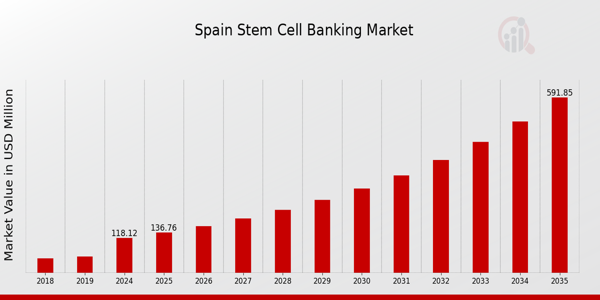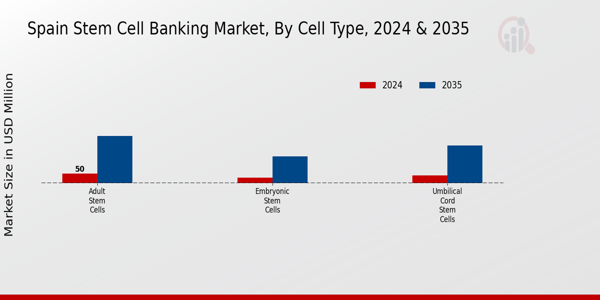Spain Stem Cell Banking Market Overview
As per MRFR analysis, the Spain Stem Cell Banking Market Size was estimated at 102.72 (USD Million) in 2023.The Spain Stem Cell Banking Market is expected to grow from 118.12(USD Million) in 2024 to 591.85 (USD Million) by 2035. The Spain Stem Cell Banking Market CAGR (growth rate) is expected to be around 15.778% during the forecast period (2025 - 2035).
Key Spain Stem Cell Banking Market Trends Highlighted
Growing knowledge of regenerative medicine and improvements in healthcare are driving major trends in the Spanish stem cell banking market. As more Spanish families become aware of the potential of stem cells to treat a range of illnesses, the demand for stem cell banking is rising.
Public education campaigns and outreach programs that educate the public on the advantages of preserving stem cells for future medical needs help to raise this awareness. The importance of personalised medicine and the development in chronic diseases are major factors driving the industry, since they urge parents to think about storing their children's stem cells for potential future treatments.
Opportunities in the Spanish market are growing, particularly as hospitals and research institutes work together to investigate novel uses for stem cells. Campaigns to raise public awareness could expand, giving Spanish families easier access to information on stem cell banking.
Furthermore, the incorporation of state-of-the-art technologies into stem cell collection and preservation procedures might further boost market development, as Spain is a pioneer in healthcare innovation. Increased governmental monitoring and a focus on openness have led to a shift in stem cell sourcing procedures towards more ethical ones, according to recent trends.
In order to facilitate growth in a way that is both compliant and socially responsible, the Spanish government has established particular legislation controlling biobanks.
Furthermore, as public perception of stem cell banking is a major factor in determining general acceptability and process participation, the industry is starting to see a stronger emphasis on stakeholder engagement. These patterns show how the Spanish market is changing and how the need for stem cell banking is still growing.

Source: Primary Research, Secondary Research, Market Research Future Database and Analyst Review
Spain Stem Cell Banking Market Drivers
Increasing Awareness of Stem Cell Treatments
In Spain, the growing awareness and acceptance of stem cell treatments among the general public is significantly driving the Spain Stem Cell Banking Market. A recent survey from the Spanish Society of Hematology found that 67% of the population is familiar with the therapeutic applications of stem cell treatments, marking a 25% increase over the past five years.
This surge in awareness is further bolstered by notable organizations such as the Spanish Network of Stem Cell Research, which has been actively campaigning to educate citizens on the potential benefits of stem cell therapies for diseases like leukemia and genetic disorders.
As individuals become more informed, there is an increasing inclination to bank stem cells, which is expected to continue driving market growth in Spain.
Rising Incidence of Chronic Diseases
Spain's increasing prevalence of chronic diseases is a significant driver for the Spain Stem Cell Banking Market. According to the Spanish Ministry of Health, approximately 30% of the Spanish population is living with at least one chronic disease, a figure that has witnessed a steady rise over the past decade. Conditions such as diabetes and heart disease are leading causes of morbidity in the country.
Organizations like the Spanish Diabetes Society are advocating for early interventions, including stem cell therapies, to manage these conditions effectively. The demand for stem cell banking is correlated with the rising incidence of chronic illnesses, highlighting the critical role that stem cells could play in future treatment options.
Regulatory Support for Stem Cell Research
Regulatory frameworks in Spain that support stem cell research and application are enhancing growth prospects in the Spain Stem Cell Banking Market. The Spanish government has established policies and legal structures promoting research in regenerative medicine.
For instance, the recent updates by the Spanish Agency of Medicines and Medical Devices regarding stem cell research have paved the way for more clinical trials and studies.
This supportive environment has encouraged major research institutions and biotechnology companies, such as IRICEN (Institute for Research in Cell and Gene Therapies), to invest heavily in stem cell banking and therapies. This regulatory backing not only leads to increased Research and Development activities but also instills greater confidence in the population regarding stem cell banking.
Technological Advancements in Storage Techniques
Technological advancements in cryopreservation and biobanking technologies are pivotal to the expansion of the Spain Stem Cell Banking Market. Innovations such as automated cryogenic storage systems and enhanced cellular viability assessment tools are making the storage and retrieval processes more efficient and cost-effective.
The Spanish National Biobank Network has been focusing on adopting these advanced technologies to provide better quality assurance and enhanced storage conditions for stem cells.
As a result, the overall reliability and accessibility of stem cell banking services are improving, driving more families in Spain to opt for these services for their newborns. The integration of technology thus acts as a significant growth factor in the stem cell banking sector.
Spain Stem Cell Banking Market Segment Insights
Stem Cell Banking Market Cell Type Insights
The Spain Stem Cell Banking Market, particularly within the Cell Type segment, is witnessing significant growth, reflective of the broader advancements in regenerative medicine and biotechnology. This segment is primarily divided into three categories: Umbilical Cord Stem Cells, Adult Stem Cells, and Embryonic Stem Cells.
Each of these types presents unique advantages and applications in medical science, showcasing the evolution of treatment methodologies. Umbilical Cord Stem Cells are particularly noteworthy, as they are collected at birth and are known for their high potency and lower immunogenicity, making them ecologically friendly and preferable in therapeutic applications.
This has led to a growing trend towards umbilical cord blood banking in Spain, motivated by a mixture of health awareness and technological improvements in storage and processing methods. Adult Stem Cells, on the other hand, offer their own distinct benefits, primarily their ability to regenerate tissues and organs, contributing significantly to treatments in hematology and oncology.
Their prominence is reflected in ongoing research and discussions surrounding the ethics and efficacy of using adult-derived cells in regenerative therapies.
Embryonic Stem Cells, while controversial due to ethical considerations, remain a critical area of focus within the Spain Stem Cell Banking Market; they possess the potential to differentiate into any cell type, hence holding promise for applications in complex conditions like neurodegenerative diseases.
The dynamic interplay of these three cell types illustrates the robust nature of the Spain Stem Cell Banking Market, with government support and healthcare initiatives further enhancing the landscape.
Overall, the market segmentation into various Cell Types not only emphasizes the diverse potential offered by stem cells but also highlights increasing consumer engagement driven by awareness of future health implications and the opportunities presented through cell therapy and tissue engineering.

Source: Primary Research, Secondary Research, Market Research Future Database and Analyst Review
Stem Cell Banking Market Bank Type Insights
The Spain Stem Cell Banking Market is characterized by a diverse segmentation based on Bank Type, which includes Private Banks, Public Banks, and Hybrid Banks. Private Banks typically dominate the landscape, driven by the increasing demand for personalized healthcare and private storage solutions.
They cater to families looking for secure and exclusive access to their stem cells, emphasizing the importance of individualized medical treatments. Public Banks, on the other hand, serve a crucial role in promoting public health by facilitating the donation and utilization of stem cells for research and therapeutic applications, thus adding significant value to the overall healthcare framework in Spain.
Hybrid Banks combine elements of both private and public banking, offering a unique combination of private storage options while also engaging in public health initiatives. This segment appeals to a growing demographic seeking both personalized and altruistic solutions.
The overall landscape reflects the evolving perceptions of stem cell therapy in Spain, with increasing awareness and favorable policies from the government encouraging participation in stem cell banking, which could lead to enhanced service offerings and market positioning in this sector.
As the markets continue to evolve, insights into trends such as technological advancements and regulatory developments suggest an optimistic outlook for the Bank Type segment in the Spain Stem Cell Banking Market.
Stem Cell Banking Market Application Insights
The Application segment of the Spain Stem Cell Banking Market has gained attention due to its potential in addressing various medical conditions. Conditions such as Thalassemia and Leukemia highlight the importance of stem cell banking in providing treatments and improving patients' quality of life.
Thalassemia, a significant hereditary blood disorder, has seen a growing need for stem cell transplants, creating awareness and demand for stem cell preservation. Additionally, Cerebral Palsy represents a critical area, with ongoing research focused on utilizing stem cells to improve motor function and cognitive abilities in affected children.
Diabetes is also becoming increasingly relevant in this market, with advancements in stem cell therapies offering hope for regenerative treatment options. Furthermore, Autism and its associated challenges underline the potential for innovative therapies through stem cell applications, drawing interest from parents and healthcare professionals alike.
The Spain Stem Cell Banking Market segmentation reflects these diverse applications, each contributing to improving healthcare outcomes and addressing unmet medical needs in the region, emphasizing the ongoing growth and development within this important market.
Spain Stem Cell Banking Market Key Players and Competitive Insights
The Spain Stem Cell Banking Market has been exhibiting significant growth in recent years, driven by increasing awareness of the potential of stem cells in regenerative medicine and ongoing advancements in technology and research capabilities.
This market is characterized by a competitive landscape in which several companies seek to establish a strong foothold by offering a variety of services related to stem cell preservation, processing, and research. The emergence of innovative techniques and a growing preference among parents for cord blood banking have further fueled the market's expansion.
With robust regulations and ethical considerations shaping the industry, companies are continuously adapting their strategies to leverage new opportunities while addressing the concerns of customers regarding safety, efficacy, and ethical standards.
StemLife has established itself as a prominent player within the Spain Stem Cell Banking Market, boasting a strong reputation for quality and reliability in stem cell preservation services. The company focuses on umbilical cord blood and tissue banking, capitalizing on the growing awareness of stem cell therapy's potential benefits.
With a commitment to high standards of operation and client education, StemLife has successfully captured a significant share of the market. Its strengths include a well-established network of medical professionals, strong customer service, and a dedicated approach to maintaining the viability and quality of stored stem cells throughout the storage period.
Furthermore, the company engages in continuous research and innovation, ensuring that it remains at the forefront of the rapidly evolving field of stem cell medicine. Celsis is another notable player in the Spain Stem Cell Banking Market, engaging in the collection, processing, and storage of cord blood and other stem cells.
The company has built a solid market presence through its comprehensive suite of services that cater to both families and healthcare providers. Celsis’ strengths lie in its advanced technology and state-of-the-art facilities, which enable the company to offer high-quality services with excellent reliability.
The company's strategic initiatives include partnerships and collaborations with leading medical institutions, which enhance its reputation and operational capabilities. Celsis also emphasizes research and development, actively contributing to innovations in the sector.
Their commitment to quality and safety in stem cell preservation, combined with a customer-oriented approach, has solidified their position in the market.
Key Companies in the Spain Stem Cell Banking Market Include:
- StemLife
- Celsis
- Natera
- Cells4Life
- Cord Blood Center
- CRIOBANK
- CryoSave
- Lifebank
- CryoGroup
- MediStem
- Vita34
- Global Stem Cells
- Biocord
- Stemcyte
Spain Stem Cell Banking Market Developments
In the Spain Stem Cell Banking Market, recent developments indicate a growing interest in regenerative medicine and cellular therapies. The demand for stem cell banking has been influenced by increased awareness of the therapeutic potential of stem cells, resulting in a rise in private and public banking services.
Major players in the market, such as StemLife, Celsis, Natera, Cells4Life, Cord Blood Center, CRIOBANK, CryoSave, Lifebank, CryoGroup, MediStem, Vita34, Global Stem Cells, Biocord, and Stemcyte, are expanding their services and capabilities to meet consumer needs.
In terms of acquisitions, there have been strategic moves among these players; for instance, in June 2022, CryoSave announced a partnership with a leading healthcare organization in Spain to enhance its service offerings, while Lifebank has focused on improving its lab facilities to boost its market presence.
Over the past two years, the stem cell banking sector has been increasingly integrated into Spain's healthcare framework, signaling robust growth and innovation potential driven by advancements in technology and R&D efforts. This trend is supported by governmental initiatives aimed at enhancing healthcare services and promoting biobanking practices across the country.
Spain Stem Cell Banking Market Segmentation Insights
Stem Cell Banking Market Cell Type Outlook
- Umbilical Cord Stem Cells
- Adult Stem Cells
- Embryonic Stem Cells
Stem Cell Banking Market Bank Type Outlook
- Private Banks
- Public Banks
- Hybrid Banks
Stem Cell Banking Market Application Outlook
- Thalassemia
- Cerebral Palsy
- Diabetes
- Leukemia
- Autism
| Report Attribute/Metric Source: |
Details |
| MARKET SIZE 2023 |
102.72(USD Million) |
| MARKET SIZE 2024 |
118.12(USD Million) |
| MARKET SIZE 2035 |
591.85(USD Million) |
| COMPOUND ANNUAL GROWTH RATE (CAGR) |
15.778% (2025 - 2035) |
| REPORT COVERAGE |
Revenue Forecast, Competitive Landscape, Growth Factors, and Trends |
| BASE YEAR |
2024 |
| MARKET FORECAST PERIOD |
2025 - 2035 |
| HISTORICAL DATA |
2019 - 2024 |
| MARKET FORECAST UNITS |
USD Million |
| KEY COMPANIES PROFILED |
StemLife, Celsis, Natera, Cells4Life, Cord Blood Center, CRIOBANK, CryoSave, Lifebank, CryoGroup, MediStem, Vita34, Global Stem Cells, Biocord, Stemcyte |
| SEGMENTS COVERED |
Cell Type, Bank Type, Application |
| KEY MARKET OPPORTUNITIES |
Increasing public awareness, Government funding initiatives, Advancements in regenerative medicine, Growing demand for personalized therapies, Expansion of healthcare infrastructure |
| KEY MARKET DYNAMICS |
increasing public awareness, regulatory advancements, rising healthcare investments, technological innovations, growing demand for personalized medicine |
| COUNTRIES COVERED |
Spain |
Frequently Asked Questions (FAQ):
The Spain Stem Cell Banking Market is projected to be valued at 118.12 USD Million in 2024.
By 2035, the Spain Stem Cell Banking Market is expected to reach a value of 591.85 USD Million.
The market is anticipated to grow at a CAGR of 15.778% from 2025 to 2035.
The market is segmented into Umbilical Cord Stem Cells, Adult Stem Cells, and Embryonic Stem Cells.
The market for Umbilical Cord Stem Cells is projected to reach 200.0 USD Million by 2035.
In 2024, the market value for Adult Stem Cells is expected to be 50.0 USD Million.
Some key players in the Spain Stem Cell Banking Market include StemLife, Celsis, Natera, and CryoSave.
The market for Embryonic Stem Cells is forecasted to reach 141.85 USD Million by 2035.
Emerging trends and advancements in regenerative medicine present substantial growth opportunities in the market.
The market is competitive with various international and domestic players vying for market share through innovation and services.
















